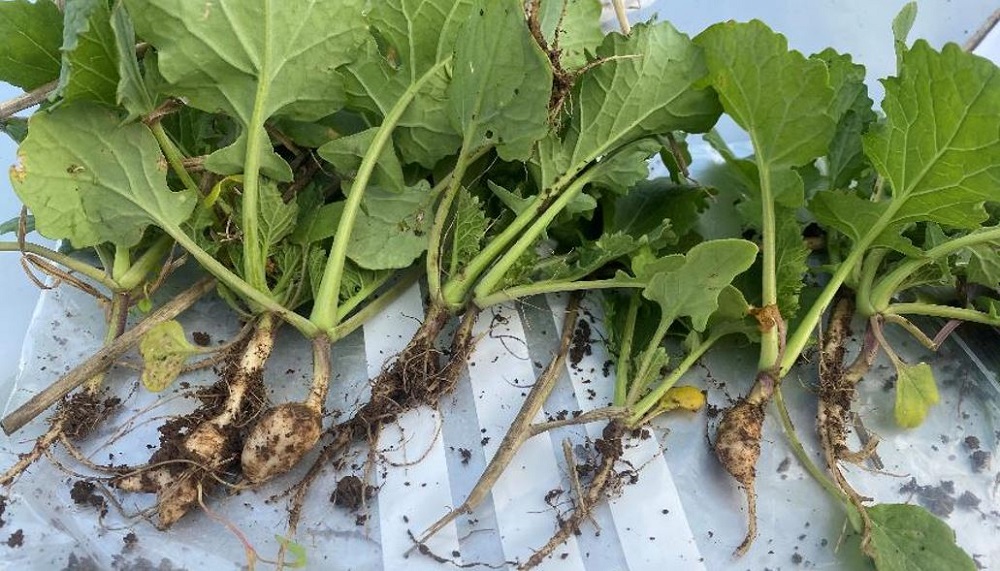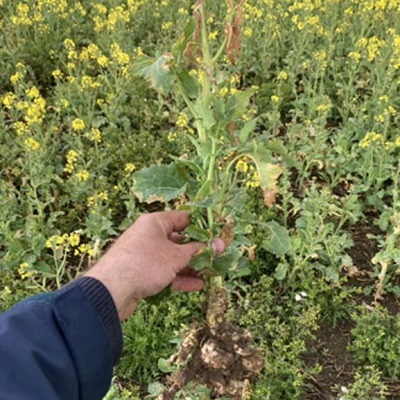‘Unexpected’ clubroot: lessons from an RL trial
Tuesday, 8 March 2022
Although we don’t test for clubroot in RL trials, the unexpected appearance of the disease at a trial site in the 2020/21 season provided a unique analysis opportunity. Paul Gosling, who leads the RL at AHDB, reveals what was learnt.
Recommended Lists (RL) home page
Clubroot resistance
Winter oilseed rape varieties with resistance to the common strains of clubroot have featured on the Recommended Lists (RL) since the variety Mendel was first recommended in 2002. However, clubroot-resistant varieties are associated with relatively large yield penalties, so they only tend to be used when clubroot issues are expected.
The RL 2022/23 features four varieties with specific recommendation for use on clubroot-infected land – including a new variety (Crossfit) that resists both clubroot and Turnip yellows virus (TuYV) for the first time.
Resistance to clubroot is not tested in RL trials and we avoid drilling trials on land with a history of clubroot, so the disease is not normally seen. Specific recommendation is based on the acceptance of breeders’ claims for traits, where the evidence supports this.
Unexpected clubroot
Despite our aim to avoid clubroot, all was not well with one of our RL trials in northern England in the autumn of 2020. Inspection revealed that clubroot was the issue (Figure 1) – despite there being no record of clubroot in the field previously. Usually, we would abandon such trials. However, the disease was relatively uniform across the trial, so we persevered in order to assess clubroot’s effects on the full variety set.
 AHDB
AHDB
Figure 1. Early signs of clubroot in oilseed rape (RL northern trial, October 2020)
Clubroot impact
By flowering, there were clear signs of clubroot symptoms (Figures 2 and 3) and differences between varieties. The most susceptible variety lacked vigour, with evidence of plant deaths (gaps in the plots).
 AHDB
AHDB
Figure 2. Characteristic club-shaped galls on roots in a susceptible oilseed rape variety (RL northern trial, May 2021)
 and a susceptible variety (right) in an RL northern trial.JPG) AHDB
AHDB
Figure 3. Difference in vigour between a clubroot-resistant oilseed rape variety (left) and a susceptible variety (right) in an RL northern trial (2021)
As this was a northern trial, only recommended and candidate varieties for the North were included. Crome was the only variety with clubroot resistance in the infected trial and it was associated with the lowest number of plant deaths (Figure 3).
.PNG) AHDB
AHDB
Figure 4. Oilseed rape plant death results for an RL northern trial (assessed in May 2021)
Key: *Recommended for the East/West region only, $ no longer recommended, # not added to the RL
At harvest, the benefit of clubroot resistance on yield was clear (Figure 5). Crome yielded 158% of controls (4.50 t/ha) in the infected trial. This compares with its North yield of 101% of controls on the current RL (trial mean of 2.98 t/ha).
We recorded a wide range of varietal yields across the infected trials. Blazen yielded particularly well, at 133% of controls (3.79 t/ha), whereas some varieties yielded below 2.5 t/ha.
It may be that some varieties are more tolerant to clubroot, although not technically resistant. Something for breeders to investigate.
.PNG) AHDB
AHDB
Figure 5. Oilseed rape variety yields, as a percentage of the controls, at an RL northern trial (assessed in Harvest 2021)
Key: *Recommended for the East/West region only, $ no longer recommended, # not added to the RL
Clubroot management
While the yield data from this trial was not used for recommendation purposes, the observations provide useful insights into clubroot management:
- Even where not previously recorded as an issue, clubroot symptoms can still appear
- Where clubroot is present, resistant varieties can effectively protect yield
The clubroot resistance in Crome was effective at this site. Based on a single dominant gene, the same resistance mechanism (termed ‘Mendel resistance’) is present in all resistant crop varieties. Growing these varieties gives some protection against the common strains of clubroot, however some strains can overcome the resistance. In some locations the resistance is no longer effective.
Frequent use of resistant varieties, or use in heavily infested soil, makes it more likely that resistance-breaking strains will establish and become dominant.
Therefore, it is important to deploy numerous integrated pest management (IPM) techniques to tackle clubroot and sustain varietal resistance.
The generally mild conditions over the 2021/22 winter, and periods of wet weather, may have increased clubroot risk in some crops. It is important to assess crops for disease symptoms and record infected areas to assist rotational planning.
Learn about clubroot risk and its management

'Unexpected' clubroot in RL trials
Agronomists' Conference 2022 presentation
Clubroot resistance in action
Some winter oilseed rape varieties on the AHDB Recommended Lists (RL) have specific recommendation for growing on land infected with common strains of clubroot. Filmed in May 2021, this video of an RL trial site shows the clear benefits associated with clubroot-resistant varieties.

Topics:
Sectors:
Tags:

